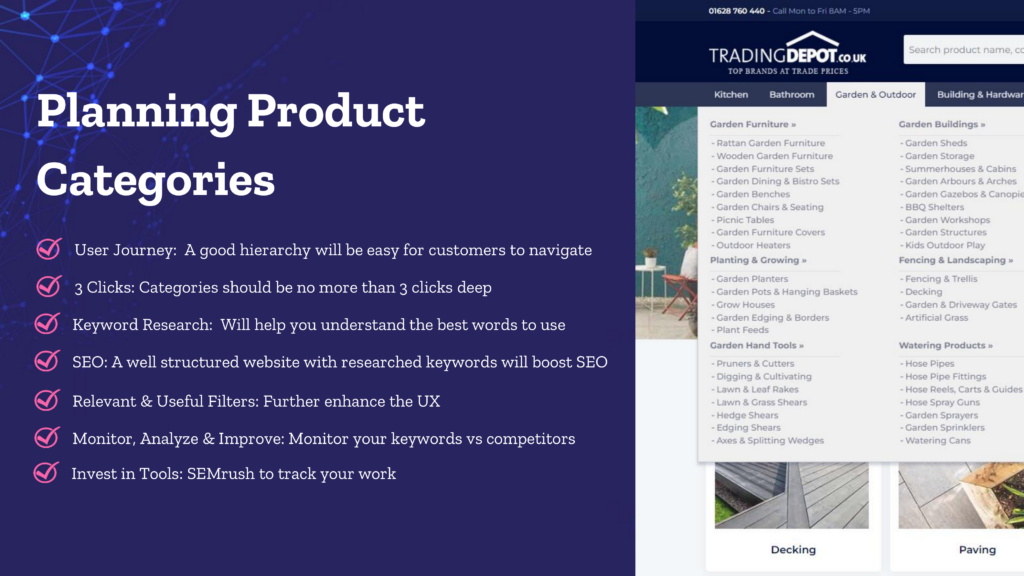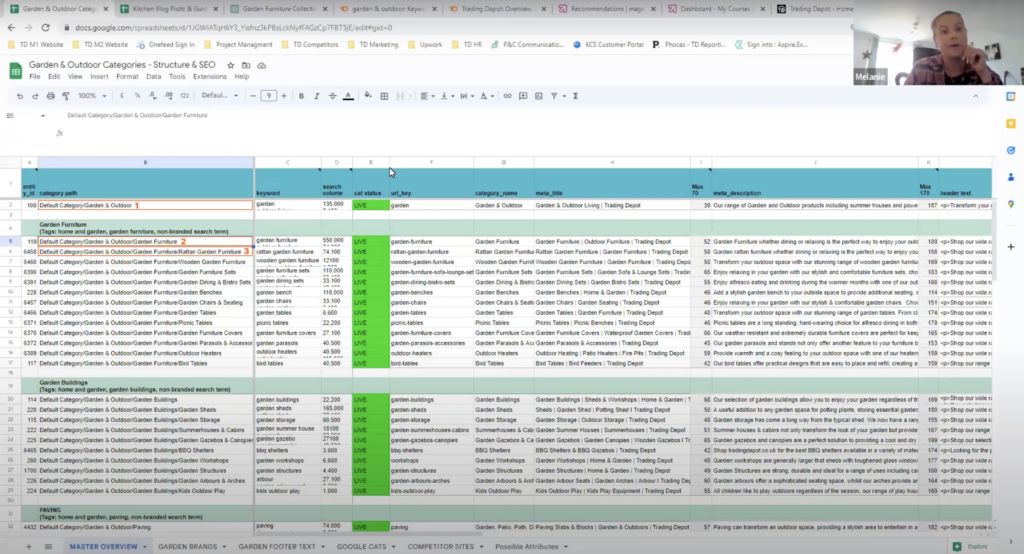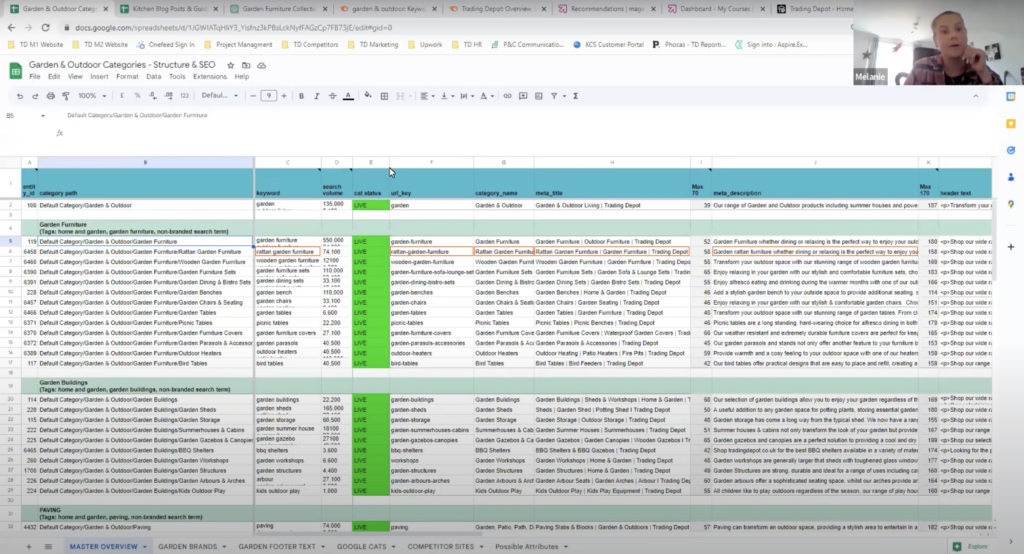Welcome to Ecommerce Camp, where today’s topic is Category Merchandising and Optimisation Strategies.
Just an overview category of merchandising is a crucial aspect of any ecommerce that involves organising and presenting your products in a way that maximises sales and profitability within a particular product category.
This includes product planning, product assortment, pricing, promotion, and placement strategies for a specific product.
Some of the strategies for category merchandising and ecommerce are number one: customer segmentation, grouping customers in segments based on their preferences, purchase behaviour, demographics, and other characteristics that can help create a personalised shopping experience.
This can be achieved by creating different product categories, landing pages, and promotions for each segment. Product categorisation, organising products into categories and subcategories based on their features and benefits. Usage that can help customers navigate the store more easily for what they’re looking for faster.
This can be achieved by creating a clear hierarchy of categories of products with suitable filter options, uh, for, and displaying related products; by optimising the order in which products are displayed in a product category based on different attributes, such as bestsellers. Most-viewed inventory levels and promotions to ensure customers are seeing the best-performing products.
First, cross-selling and upselling display related and complimentary products on pages to encourage customers to buy more and increase the average order value through seasonal merchandising updates, product categories, and promotions based on seasonal trends and holidays. And then we’ve got search engine optimisation, optimising product categories and landing pages for search engines to improve the visibility and ranking of the store in search engines.
These are some of the elements that we’ll be covering today.
The Hierarchy of Product Categorisation & SEO
And the element that I’m starting on is the hierarchy of product categorisation and search engine optimisation.
This is the element that I mentioned, which is:
Product categorisation
Organising products into categories and subcategories based on their features, benefits, and usage can help customers navigate the store more easily and find what they are looking for faster. This can be achieved by creating a clear hierarchy of categories, using filters and sorting options, and displaying related products.
Merchandising: Planning Product Categories
So let’s dive into that a little bit more.
- The user journey will make the website and the hierarchy of products easy for customers to navigate. The rule of thumb here is that the categories are for customers to find the final product listing; there should never be more than three clicks in the user journey.

- To start, use your strategy and do your keyword research on how to best structure your product. Categories will come with doing a lot of background investigation. With that, we’ll take a look into some of those elements afterward.
- Alongside keyword research is SEO, so a well-structured website with well-researched keywords will boost organic SEO on your site.
- The use of relevant and useful filters will further enhance the user experience.
- And then, as with anything, it’s always important to monitor, analyse, and improve your results.
- Invest in tools. One of the tools that I’m going to show you here is SEMrush. So another element that I wanted to touch on is for SEO, and it always has been with Google, the dominant player out there, that content is king.
What we’re going to look at here is our keyword research and then using those in the most important elements. That’s your URL key, your meta title, your meta description, your <H1> tag, and then your opening paragraph.
Here, I wanted to provide a bit of an example. The reason that I’m using Garden and Outdoor is because we’re in spring at the moment, and for us, that’s our primary category to be promoting this time of year. What we tend to do is put together a structure and a strategy for building our category structure within a spreadsheet here.

Our first click will be in our Garden and outdoors >
Our second click will be Garden furniture >
And the third click here is Rattan garden furniture >
So when we’re looking at this, we look at our product assortment.
– What are the best words to use to define and put products within a category?
Giving you a good example of the Rattan garden furniture here on our website:

We have quite a few product types that fall into this category, and it’s a popular material for people to purchase. We researched this keyword because we first want to find out how relevant it is to the UK, and I’m going to show you.
SEMrush has this wonderful tool called the Keyword Magic Tool. From here, we can start to research these keywords and their popularity. This is looking at the United Kingdom, and it’s monthly.
– How often is this word searched for?
Give it a moment, and it will come up. Here, you can see it’s very popular.

All the kinds of synonyms that people are searching for around this product type and the volume that it gets searched on. So we know this is a very popular word.
As I mentioned with those important elements, we want to make sure that those keywords are included in our URL key, our category name, which will be our <H1>, our meta title, our meta description, and then our opening paragraph.

I can show you that here as well. We can see we’ve got Garden and outdoor furniture; we’ve got Garden furniture; and then we’ve got Rattan garden furniture. We’ve got it in our <H1> title.

We’ve got it in a well-written, optimised intro paragraph that repeats that word in a logical format.
And then we can use the META SEO inspector tool to see that we’ve also got this here in our meta description on the page.
NOTE:
This script encapsulates an enlightening webinar featuring Melanie Day, where she navigates the intricate realms of Category Merchandising. This session promises an in-depth exploration of the intricacies of optimising product categories to enhance customer engagement and drive sales.
To access this enriching resource, we’ve simplified the process for you. Click below to watch the full recording:

Need Specific, Targeted Advice For Your Store?
Whether you’re embarking on your first steps into the world of e-commerce or already running an established business, don’t hesitate to contact us. Our dedicated team is here to provide unwavering support and assistance throughout your entire journey.




